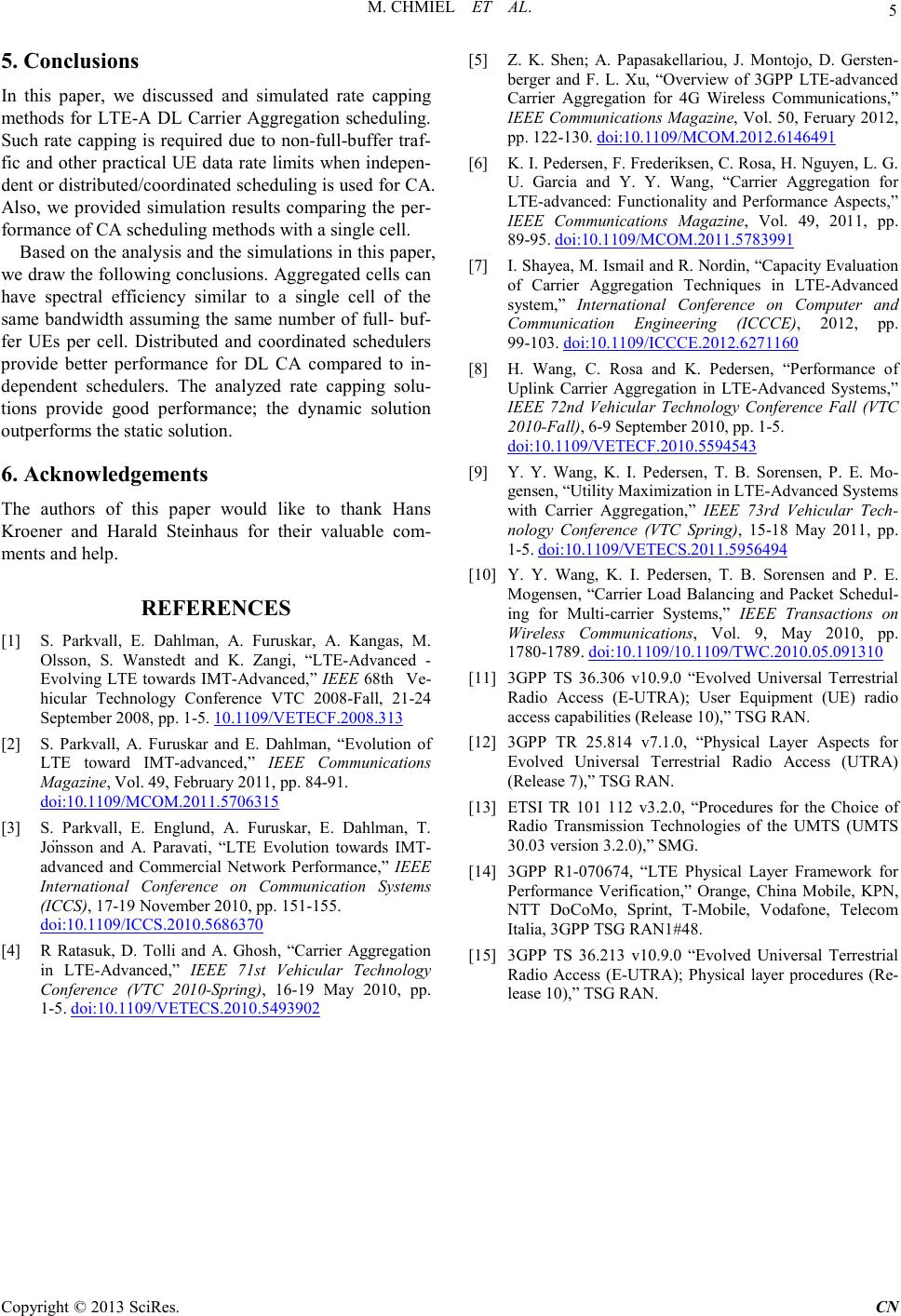
M. CHMIEL ET AL.
Copyright © 2013 SciRes. CN
5. Conclusions
In this paper, we discussed and simulated rate capping
methods for LTE-A DL Carrier Aggregation scheduling.
Such rate capping is required due to non -full-buffer traf-
fic and other practical UE data rate limits when indepen-
dent or distributed /coord inated scheduling is us ed fo r C A.
Also, we provided simulation results comparing the per-
formance of CA s cheduli ng methods with a singl e cell .
Base d o n the a nal ysis a nd t he simul at ions i n thi s p ape r,
we draw the following conclusions. Aggregated cells can
have spectral efficiency similar to a single cell of the
same bandwidth assuming the same number of full- buf-
fer UEs per cell. Distributed and coordinated schedulers
provide better performance for DL CA compared to in-
dependent schedulers. The analyzed rate capping solu-
tions provide good performance; the dynamic solution
outperforms the static solutio n.
6. Acknowledgements
The authors of this paper would like to thank Hans
Kroener and Harald Steinhaus for their valuable com-
ments and help.
REFERENCES
[1] S. Parkvall, E. Dahlman, A. Furuskar, A. Kangas, M.
Olsson, S. Wanstedt and K. Zangi, “LTE-Advanced -
Evolving LTE towards IMT-Advanced,” IEEE 68th Ve-
hicular Technology Conference VTC 2008-Fall, 21-24
September 2008, pp. 1-5. 10.1109/VETECF.2008.313
[2] S. Parkvall, A. Furuskar and E. Dahlman, “Evolution of
LTE toward IMT-advanced,” IEEE Communications
Magazine, Vol. 49, February 2011, pp. 84-91.
doi:10.1109/MCOM.2011.5706315
[3] S. Parkvall, E. Englund, A. Furuskar, E. Dahlman, T.
Jönsson and A. Paravati, “LTE Evolution towards IMT-
advanced and Commercial Network Performance,” IEEE
International Conference on Communication Systems
(ICCS), 17-19 November 2010, pp. 151-155.
doi:10.1109/ICCS.2010.5686370
[4] R Ratasuk, D. Tolli and A. Ghosh, “Carrier Aggregation
in LTE-Advanced,” IEEE 71st Vehicular Technology
Conference (VTC 2010-Spring), 16-19 May 2010, pp.
1-5. doi:10.1109/VETECS.2010.5493902
[5] Z. K. Shen; A. Papasakellariou, J. Montojo, D. Gersten-
berger and F. L. Xu, “Overview of 3GPP LTE-advanced
Carrier Aggregation for 4G Wireless Communications,”
IEEE Communications Magazine, Vol. 50, Feruary 2012,
pp. 122-130. doi:10.1109/MCOM.2012.6146491
[6] K. I. Pedersen, F. Freder iksen, C. Rosa, H. Nguyen, L. G.
U. Garcia and Y. Y. Wang, “Carrier Aggregation for
LTE-advanced: Functionality and Performance Aspects,”
IEEE Communications Magazine, Vol. 49, 2011, pp.
89-95. doi:10.1109/MCOM.2011.5783991
[7] I. S hayea, M. Ismail an d R. Nordin, “Cap acity Evaluation
of Carrier Aggregation Techniques in LTE-Advanced
system,” Int ernational Conference on Computer and
Communication Engineering (ICCCE), 2012, pp.
99-103. doi:10.1109/ICCCE.2012.6271160
[8] H. Wang, C. Rosa and K. Pedersen, “Performance of
Uplink Carrier Aggregation in LTE-Advanced Systems,”
IEEE 72nd Vehicular Technology Conference Fall (VTC
2010-Fall), 6-9 Septe mber 2010, pp. 1-5.
doi:10.1109/VETECF.2010.5594543
[9] Y. Y. Wang, K. I. Pedersen, T. B. Sorensen, P. E. Mo-
gensen, “Utility Maximization in LTE-Advanced S yste ms
with Carrier Aggregation,” IEEE 73rd Vehicular Tech-
nology Conference (VTC Spring), 15-18 May 2011, pp.
1-5. doi:10.1109/VETECS.2011.5956494
[10] Y. Y. Wang, K. I. Pedersen, T. B. Sorensen and P. E.
Mogensen, “Carrier Load Balancing and Packet Schedul-
ing for Multi-carrier Systems,” IEEE Transactions on
Wireless Communications, Vol. 9, May 2010, pp.
1780-1789. doi:10.1109/10.1109/TWC.2010.05.091310
[11] 3GPP TS 36.306 v10.9.0 “Evolved Universal Terrestrial
Radio Access (E-UTRA); User Equipment (UE) radio
access cap abilities (Release 1 0),” TSG RAN.
[12] 3GPP TR 25.814 v7.1.0, “Physical Layer Aspects for
Evolved Universal Terrestrial Radio Access (UTRA)
(Release 7),” TSG RAN.
[13] ETSI TR 101 112 v3.2.0, “Procedures for the Choice of
Radio Transmission Technologies of the UMTS (UMTS
30.03 version 3.2.0),” SMG.
[14] 3GPP R1-070674, “LTE Physical Layer Frame work for
Performance Verification,” Orange, China Mobile, KPN,
NTT DoCoMo, Sprint, T-Mobile, Vodafone, Telecom
Italia, 3GPP TSG RAN1#48.
[15] 3GPP TS 36.213 v10.9.0 “Evolved Universal Terrestrial
Radio Access (E-UTRA); Physical layer procedures (Re-
lease 10 ),” TSG RAN.